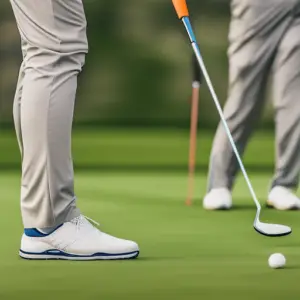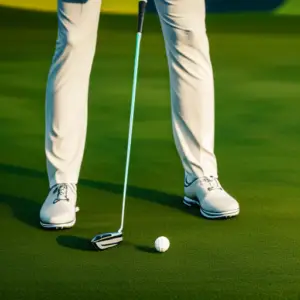Last Updated on October 17, 2023
Welcome, golfers. Today we’re going to talk about how to transfer weight in a golf swing. It’s an important skill for any golfer to master, and it can make all the difference when you are out on the course. If you have been struggling with your swings lately, then this article is just what you need. Let me show you how easy it can be to start transferring your weight like a pro.
First of all, let’s talk about why it’s so important to focus on weight transfer while swinging. When done correctly, transferring your weight helps increase power and accuracy by creating more force at impact. This means that not only will your ball go further than before, but also far more accurately too. Who doesn’t want that?
Finally, I’m gonna walk you through some simple steps which will help you get started with transferring your own body weight as part of your swing technique. You’ll learn exactly what needs to be done and how to do it right every time – giving yourself the best possible chance for success out there on the course. So without further ado – let’s begin.
Understanding The Physics Of Weight Transfer
Golfers of all levels must understand the physics behind weight transfer in order to improve their swing mechanics. In a golf swing, body mechanics play an essential role and are heavily impacted by the movement of one’s weight. To be successful on the course, it is crucial that you understand how your weight influences your swing.
Weight transfer is a key factor in creating efficient swing mechanics. During the backswing, most of your weight should move towards the target foot as you turn into it from your address position. As you rotate through impact, shift your weight back onto your lead leg for maximum power and control over the ball. An effective way to practice this motion is to use some form of resistance training like TRX bands or stability balls while swinging with a club. Through this type of exercise, you can better develop muscle memory for proper weight transfer during a full golf swing.
By understanding and mastering these fundamentals about weight transfer within a golf swing, you’ll take huge strides towards improving your game.
Grip And Posture
Now that you know the physics of weight transfer, it’s time to get into grip and posture. To ensure a proper weight shift in your golf swing, there are three important elements: grip position, posture setup, and hand placement.
Your stance should be comfortable and provide stability for your body throughout the swing. Your feet should be slightly wider than shoulder-width apart, with about 70% of your weight on the instep of each foot. This will give you balance when swinging and help maximize power from the ground up.
When positioning your hands, think “palms out”. Make sure both palms face outward, so they stay in line with clubface alignment as you swing down through impact. Also, make sure to keep good body alignment during this part of the set-up by keeping your head steady over the ball while keeping your arms close to your chest. Lastly, don’t forget to keep an eye on clubface alignment; if it is open or closed at the address, then it will remain so throughout the entire motion, including impact.
These steps must all be done together in order to generate maximum power with every shot. Keeping these points in mind before taking a practice swing can help optimize performance and accuracy when hitting shots on course. With solid grip and posture fundamentals established, let’s move on to learning how to properly execute a powerful weight shifting golf swing.
Wrist Hinge And Flexibility

When it comes to transferring weight in a golf swing, the wrist hinge is essential. By properly flexing and rotating your wrists during the downswing, you can help direct power from your lower body into the clubface for maximum distance and control. To ensure proper form, there are certain flexibility exercises that should be practised regularly.
- Flexible forearms will help with arm extension throughout the swing * A strong grip promotes better hip rotation, and an on-plane backswing * Regular stretching of the wrists helps promote full forearm and bodyweight shift.
These exercises will not only improve your wrist hinges but also assist in generating maximum power through optimal club rotation. Your arms should move freely while maintaining their connection to your torso as you rotate towards impact. This ensures that all parts of your swing work together efficiently. In addition, keeping good posture during this phase of the swing is key – you want your shoulders to stay low relative to your hips so that you don’t lose any kinetic energy going forward. Practising these drills consistently will help increase both strength and mobility in those areas necessary for successful weight transfer.
Core Strength And Balance
Now that you have a better understanding of the wrist hinge and flexibility involved in golf, it’s time to move on to core strength and balance. Core strength is essential for weight transfer during the swing, as it acts like an anchor while allowing proper rotation. Balance training helps promote this stability in your body; by learning how to maintain control despite the movement, you can ensure more consistent results with every shot.
| Proper Golf Balance | Improve Weight Transfer |
|---|---|
| Increase core strength | Develop stable base |
| Stabilize muscles | Keep feet firmly planted |
| Train balanced movements | Utilize legs correctly |
To help improve your core strength and balance, focus on exercises such as planks or deadlifts that build up the muscles used throughout the swing. Additionally, practice balancing drills specific to golfing, such as single-leg squats or lateral steps, which target hip mobility and lateral stability. When done properly, these drills will not only strengthen your core but also teach your body how to shift its weight effectively within each shot. This way, when it comes time to hit the ball, you’ll be sure to maintain strong form with smooth transitions from start to finish. In turn, you should notice improved accuracy and power with each strike.
Practising Proper Weight Transfer In Training Drills

Learning proper weight transfer in a golf swing is essential for any golfer. To ensure the best results, it’s important to practice drills that focus on this element of your game. Training drills can help you become more aware of how your body moves while swinging and identify areas where you need improvement. Weight transfer drills are especially helpful when trying to learn how to shift your weight properly during each step of the swing.
One great drill for learning proper weight transfer is to hit balls from an address position with one leg slightly off the ground. This helps you feel what it’s like to have less support coming from your feet, which forces you to rely more heavily on shifting your weight as you go through the motion of a full shot. You should also try hitting some shots without letting both feet touch the ground again until after impact; this helps encourage a smooth transition between backswing and downswing.
To further develop good habits, work on those same movements using training aids such as balance boards or weighted clubs. Balance boards challenge you by forcing you to stay balanced throughout the entire swing—you won’t be able to make up for any flaws if there’s no solid base beneath you. Meanwhile, weighted clubs allow you to experience different levels of resistance in order to keep all phases of your swing connected and consistent. By incorporating these drills into regular practice sessions, golfers can improve their understanding of how they move their bodies while swinging and ultimately enhance their overall performance.
Mental Preparation For Weight Transfer In A Game Situation
Weight transfer should be a natural part of your game and not something you have to think about all the time. Before every shot, take a few moments to consider your club selection, as well as where you want to hit the ball and how much power you need behind it. Visualize yourself swinging with good weight transfer; imagine feeling your body shift from one side to the other at impact. This mental preparation will help ensure that when you get on the course, you’ll execute each swing correctly and with confidence.
When out on the course, stay focused on making quality swings rather than trying too hard or thinking about what could go wrong during your round. Remember that although there are certain elements of technique involved in a successful golf swing, ultimately, it’s more important to keep an even head and play within yourself no matter what situation arises. If you can do this while also remembering to focus on executing solid weight transfer throughout your swing, then you’re sure to enjoy success on the links.
Intentional Weight Shift To Increase Distance

Transferring your weight correctly during a golf swing is essential to gain maximum distance. To ensure you are performing this manoeuvre properly, it’s important to understand the process and practice intentional shifts in your swing. Through understanding how weight shifting works, you can use core strength and mental preparation as aids for optimal performance on the course.
Weight shift starts with loading up power from the back leg throughout the downswing. This involves turning your shoulders away from the ball while keeping your head still and maintaining good posture – all at once. As you reach impact, unloading of power should be done by transferring this energy into forward motion through the front foot. The whole process needs to be seamless if you want to increase speed and achieve more distance off each shot.
Practising these steps will help train muscle memory so that when it comes time to perform on the course, your body knows what to do instinctively. It may take some trial-and-error before you get comfortable with these movements but stick with it, and eventually, they’ll become second nature. With proper attention paid towards weight transfer in a golf swing, players can gain significant amounts of yardage compared to an approach without deliberate movement of their body weight.
Frequently Asked Questions
How Much Weight Should I Transfer In A Golf Swing?
The amount of weight transfer in a golf swing is an important factor, as it helps to increase your power and control with each shot. Knowing how much weight should be transferred during the swing will help you improve your technique and take your game to the next level.
When transferring weight in a golf swing, it’s essential to understand the key elements such as:
- Weight transfer amount
- Golf swing transfer
- Transfer weight golf
- Golf weight transfer
- Swing transfer weight
These are all factors that affect how effectively and efficiently you can move your body weight during the backswing and follow through. As an instructor, I recommend focusing on these five points when analyzing your own technique or giving advice to others. If done correctly, this will ensure that you get the maximum performance out of every single shot.
It’s also important to remember that everyone has different levels of strength and flexibility, which must be taken into account while adjusting your stance for optimal results. The best way to achieve this balance is by regularly practising so you can develop muscle memory and become more consistent with each stroke. Additionally, having a good understanding of physics principles like torque, speed, inertia etc., will further aid in developing the proper form for a successful golf swing.
How Can I Improve My Wrist Hinge And Flexibility For A Better Weight Transfer In A Golf Swing?
Improving wrist hinge and flexibility is one of the most effective ways to improve weight transfer in a golf swing. These two components play an important role in providing better distance off the tee, as well as more control over your shots. Here are some tips that can help you develop these skills:
- Work on proper posture – A good stance leads to greater power and accuracy with every shot. Make sure your feet are shoulder-width apart and keep your spine straight throughout the entire swing.
- Strengthen your wrists – Wrist strength will allow for smoother execution of all parts of the swing, including weight transfer. Practice exercises like hand flexing, gripping a club between opposite hands and squeezing rubber balls to increase strength and stability in your wrists.
- Use drills – Drills focus specifically on technique which allows you to practice different aspects of the golf swing, such as hip turn or shoulder rotation. Use specific drills that target movements related to weight shift for best results.
- Stretch before playing – Mobility exercises like dynamic stretching, yoga poses, and foam rolling can help prepare your body for a round of golf by loosening up tight muscles and increasing the range of motion in key areas like the hips and shoulders. This will aid in improving wrist hinge and overall flexibility during the actual swing itself.
It’s essential that you take time to warm up properly prior to each round so that you can feel comfortable executing each part of the swing accurately without any restrictions from tight muscles or lack of mobility due to stiffness. With regular practice using these tips above, you’ll be able to make improvements in both wrist hinge and flexibility which should result in improved weight transfer when swinging a club.
Conclusion
It’s important to understand how weight transfer affects your golf swing. When done correctly, transferring weight can help you generate more power and distance with each shot. To make sure that you are transferring the correct amount of weight during your swing, it is best to practice with a qualified instructor who can provide feedback and guidance.
By focusing on improving wrist hinge and flexibility, you will be able to execute an effective weight transfer in your golf swing. This will enable you to generate more power, increase clubhead speed and ultimately hit longer shots. With consistent practice and instruction from an experienced coach, you should notice significant improvements in ball flight trajectory as well as increased distances off the tee.
As long as you apply proper technique when initiating a weight transfer in your golf swing, this simple adjustment can have a dramatic effect on performance out on the course. By making small adjustments over time and practising consistently, I’m confident that any golfer can improve their game by mastering the art of weight transfer.



